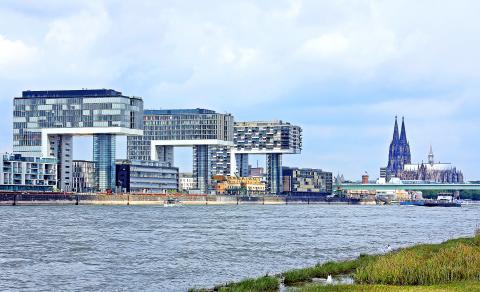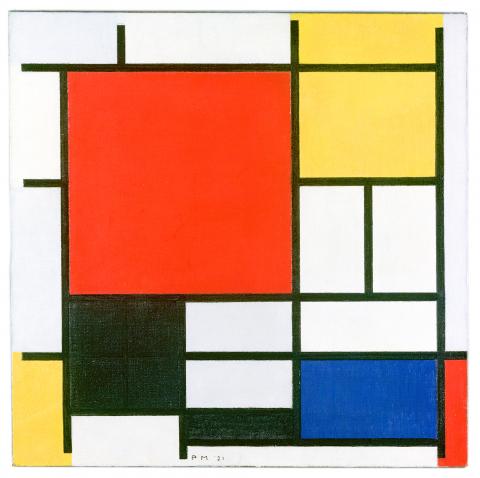You often hear in Taiwan people complaining of unsightly surroundings and an ugly environment, with box-like, concrete, soulless buildings — the “much-admired” Republic of China “aesthetic” — compared to traditional Qing-era architecture or Japanese colonial period architecture such as Japanese-style wooden bungalows or Western-style buildings combining Baroque elements.
It is possible to see white, boxy buildings throughout the world, in what used to be known as the “international style” that originated in Germany’s Bauhaus movement. Back then, the Bauhaus square-ish buildings were regarded as avant garde.
The word “Bauhaus” combines the German “bau” (to build) and “haus” (house). It was the name of a design institute established in Weimer, in eastern Germany, in 1919 — exactly a century ago — by the architect Walter Gropius (1883-1969).

Photo: Pixabay
照片: Pixabay
In Europe at the time, the idea that “ornamentation is a crime” had taken hold: that is, any ostentatious ornamentation on architecture or design was done for the benefit of the monarchy or aristocracy, and the more decorous a building was, the more it meant that the craftsmen working on it had been exploited.
Compared to the ostentatious, somber, meticulously detailed traditional architecture of the time, with its commemorative function, being built of stone to ensure survival into perpetuity, the simpler Bauhaus style emphasized utility, simplicity and reproducibility, which could be used by ordinary people and mass produced on an industrial scale. The school building (photo 2) designed by Gropius and the staff and students of the Bauhaus school after it relocated to Dessau in 1925 is an exemplar of this style. The essence of the “less is more” principle stated by Ludwig Mies van der Rohe (1886-1969), the school’s last principal, is still discernible in the simple, clean designs of Apple and Muji products today.
Gropius regarded architecture as a “total” work of art (Gesamtkunstwerk), including painting, interior design, furniture, textiles and performance, and brought artists and craftsmen from all these disciplines under one roof to study in the school. The modern approach to teaching art and design retains vestiges of the foundations laid by Bauhaus even today. With this cross-pollination of ideas and styles, we can see the influence of French Cubism and Dutch Neoplasticism (De Stijl, utilizing form and strong colors, with monochrome shapes consisting of straight horizontal and vertical lines filled with primary colors, as in photo 3) in Bauhaus architecture.

Photo: Wikimedia Commons
照片:維基共享資源
The end of Bauhaus came in 1933 at the hands of the Nazis, who criticized it for promoting internationalism, and of being antithetical to German nationalism and pro-communist. The Nazis also believed that the flat roofs favored by Bauhaus derived from Jewish design, and was unsuitable for the climate in Germany, where it often rained and snowed.
Chased out by the Nazis, the teachers and students of the Bauhaus school moved to America, where they would take up teaching positions in architecture institutes in Harvard and Chicago, their students ensuring the “international style” would be adopted the world over. The UN Secretariat Building in New York and the glass Pyramide du Louvre in Paris were both influenced by the glass Curtain Wall architectural design devised by the Bauhaus school. The white, box-like buildings of the international style have become part of the global architectural vocabulary, even if its expression is sometimes debased and soulless. The influence of Bauhaus is everywhere, ubiquitous to the extent that it is sometimes difficult to recognize it, similar to the difficulty in distinguishing the origins of a stranger who has no discernible accent.
(Translated by Paul Cooper)

Photo: Wikimedia Commons
照片:維基共享資源
在台灣,常有人抱怨放眼周遭,盡是醜陋的環境、水泥方塊毫無特色的建築,相較於清朝古建築以及日治時期的建築—日式木造平房、融合西洋巴洛克風格的洋樓,「中華民國美學」真是令人不敢恭維。
其實在當時,全世界都在蓋這種白色方盒子,名曰「國際風格」,輾轉源自德國的「包浩斯」(Bauhaus),而包浩斯的方塊建築當初是很前衛的。
「Bauhaus」,是由德文「bau」(建造)和「haus」(房屋)結合起來的,這是一所設計學院,一九一九年由建築師葛羅培斯(一八八三~一九六九)在德國東部的威瑪創立,距今正好一百週年。
當時歐洲有一派意識形態認為「裝飾即罪惡」—建築和設計的那些繁複裝飾,都是為王公貴族服務,因此裝飾越多,對工匠的剝削就越大。
因此,相對於傳統建築的華麗、沉重、多細節、以石材追求不朽的紀念性,包浩斯明快而輕盈,強調「實用、簡約、體系化」,要讓所有人民都能夠使用,並可工業化大量生產。包浩斯一九二五年遷校至德紹後,葛羅培斯等師生所設計的校舍即為代表【圖二】。包浩斯最後一任校長密斯(一八八六~一九六九)更提出了「Less is more.」(少即是多)的原則,現今蘋果電子產品、無印良品的簡潔風格,也可以看到傳承自包浩斯的精神。
葛羅培斯將建築視為綜合藝術,結合了繪畫、室內設計、家具、織品、劇場等,因此網羅這些領域的藝術家和工匠來訓練學生,現今的藝術設計教育,皆不脫包浩斯所奠定的基礎。這樣的跨領域思維,讓我們在包浩斯建築中,可以看到法國的立體派以及荷蘭風格派的影響(風格派將造型與顏色濃縮為水平與垂直線條、三原色與黑白,例如【圖三】)。
包浩斯最後在一九三三年被納粹全面封殺,理由是包浩斯鼓吹國際主義—因此是反德國的、共產黨的;包浩斯的平屋頂也被指控為猶太主義設計,因它不適合德國多雨雪的氣候。
包浩斯的師生於是輾轉來到美國,任教於哈佛、芝加哥等建築學院,徒子徒孫的影響力讓「國際風格」更無遠弗屆。美國紐約的聯合國秘書處大樓、法國羅浮宮的玻璃金字塔等,都受到包浩斯玻璃帷幕牆結構的影響。國際風格的白色方盒子更成為全球的語彙,甚至流於庸俗化——它們無所不在,因此不感到其存在,就像是「沒有口音」,無法分辨這是什麼地方、你從哪裡來。
(台北時報林俐凱)

本文由生成式 AI 協作,本刊編輯編修。 Have you ever wondered how an athlete who once performed flawlessly can unexpectedly struggle with the simplest tasks? Imagine an __1__ pitcher who suddenly can’t find the strike zone—this is the “yips” in action. This __2__ phenomenon primarily affects athletes in sports like baseball and golf. It is characterized by a sudden loss of motor skills, leading to difficulties with routine actions that were __3__ before, such as a pitcher’s throw or a golfer’s putt. For instance, American baseball pitcher Steve Blass, who had a stellar performance in the 1971 World Series, suffered a sudden inability

A: Apart from 2NE1, Rain and Maroon 5, Japanese band Yoasobi is set to hold two shows in Taipei this weekend. B: Yoasobi? A: Yoasobi is a J-pop duo formed by Ayase and Ikura in 2019, and it’s loved by young people. Haven’t you heard? B: Oops, I’m feeling a little old. A: It sings the theme songs of “Oshi No Ko” (“My Idol’s Children”) and other TV series, leading it to gain popularity among young people. A: 除了2NE1、Rain、魔力紅,日本熱門樂團Yoasobi本週末也將連唱兩場。 B: Yoasobi樂團? A: 這是由Ayase、Ikura在2019年組成的雙人團體,近年來大受年輕人歡迎!你沒聽過嗎? B: 天啊我覺得自己老了。 A: 他們唱了《我推的孩子》等人氣影視作品主題曲,所以大受年輕人喜愛。 (By Eddy Chang, Taipei Times/台北時報張聖恩)

A: Happy Year of the Snake! Did you do anything special during the Lunar New Year holiday? B: I went to K-pop girl group Apink’s concert. How about you? A: I just stayed at home. But I’m going to girl group 2NE1’s show on Saturday. B: Wow, I really love their megahit “I Am the Best,” better known by its Korean title “Naega jeil jal naga.” A: I’m so glad that 2NE1 reunited last year, eight years after they disbanded in 2016. A: 蛇年快樂!你春節有做什麼特別活動嗎? B: 我去了南韓女團Apink的演唱會,你呢? A: 我都宅在家裡,不過這週六要去韓流天團2NE1的演唱會。 B: 我愛該團神曲《我最紅》,韓文歌名《Naega jeil jal naga》超洗腦。 A: 她們2016年解散8年後,去年終於合體真令人開心。 (By Eddy Chang, Taipei

The crimson hue of theater seats is a long-standing tradition that has persisted through centuries and across continents. This seemingly universal choice is influenced by a fascinating combination of historical, visual, and practical factors. Inspired by the lavish aesthetics of Italian opera houses, where red has been a dominant color, movie theaters often adopt the red color __1__—a tradition that emerged in the late 19th and early 20th centuries. Associated with power, the color red was used in opera houses to __2__ an image of sophistication and grandeur. As opera spread across Europe, more and more opera houses adopted